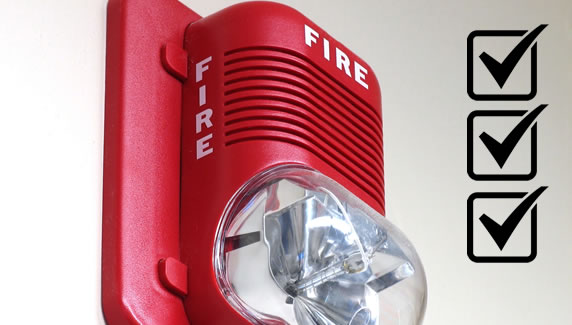 The auditing of tenant space with regards to fire & life safety can be a challenge. There’s the delicate balance of trying to view all interior rooms and areas of the space being audited, be it small or large, and doing so without disrupting the tenants business in any manner. A look at key items and certain areas will help lead to a safer work environment for all.
The auditing of tenant space with regards to fire & life safety can be a challenge. There’s the delicate balance of trying to view all interior rooms and areas of the space being audited, be it small or large, and doing so without disrupting the tenants business in any manner. A look at key items and certain areas will help lead to a safer work environment for all.
Fire Extinguishers
The typical size fire extinguisher for an office space is a 2A:10BC they weigh 10 lbs or less. They should be placed ever 75’ of travel, easily visible and accessible, and not hidden by plants or anything else.
As per NFPA 10, extinguishers with a weight up to 40 pounds should be installed so the top of the extinguisher doesn’t exceed 5 feet above the floor. Extinguishers weighing over 40 lbs. should be installed so that the top of the extinguisher is not more than 3 feet above the floor. Extinguishers should be mounted on a proper bracket for the weight and size of the extinguisher.
The display needle on the gauge should be in the green area on the dial which indicates the extinguisher is properly charged and ready for use. If the needle is to the left side of the gauge it needs to be charged and serviced, additionally if the needle is to the right side of the gauge, it has been overcharged and may not function properly and should be checked and serviced immediately. The pull pin attached to the round ring at the handle of the extinguisher needs to be secure and in place, this pin is pulled before the extinguisher can be used, expelling the agent from inside the canister.
Fire extinguishers should be serviced and properly tagged by a licensed company that specializes in this line of work, most are licensed by the State Fire Marshal – example, firms that provide this service in California are licensed, certified and tested by the California State Fire Marshal’s Office, keep in mind that every state and jurisdiction are different.
Fire Sprinkler Heads & Escutcheons
If the tenant space has fire sprinkler heads at the ceiling, first make sure there is no storage of anything directly below any sprinkler heads – nothing closer than 18” from the top of the stored material to the bottom of the sprinkler head. Make certain each fire sprinkler head has an escutcheon ring, this sleeve type device fits between the sprinkler head and the branch line coming through the ceiling tile. If the escutcheon ring is missing and there’s a fire, heat will escape through this opening and the sprinkler head won’t activate. Two last notes, make sure tenants don’t hang anything from the fire sprinkler heads, make sure all ceiling tiles are in place, not missing, broken, or have any holes as heat from a fire will escape here and the sprinkler head will not activate when needed.
Smoke Detectors, Strobe – Audible Devices, & Manual Pull Stations
If the tenant space is equipped with any of these items, they must be visible and accessible. Smoke detectors should be attached to their base at the ceiling and should not be hanging by their electrical wires. Additionally, nothing should be attached to or hanging from a smoke detector.
Visual strobe and audible speaker devices should not have anything attached to them or concealing them, no plastic covers of any kind or any type of tape that would muffle the sound coming from a speaker.
Manual pull stations, should not be obstructed and also need to be visible and accessible to everyone within the tenant space.
Improper Use of Extension Cords
Every tenant needs and uses extension cords. Per NFPA and International Codes, extension cords should not be used as a substitute for permanent wiring. In the photo above we see a bare wire on the carpet, the older second plug from the left has tape attached where the wire connects to the plug. This is a fire hazard waiting to happen.
Exit Doors
A few important notes regarding exits from within the tenant space. First, exit paths leading to an exit door should not be obstructed in any manner. There should be no storage of anything that would obstruct the exit or render the exit hazardous, this includes but is not limited to seasonal decorations. Exit doors should be operable from the inside without the use of a key or any special knowledge or effort. All exit doors should be marked or signed so they are readily distinguishable from any adjacent construction.
Exit doors should latch and close properly. If exit doors are part of fire rated exit corridor, all frames for exit doors should have proper UL listed smoke gaskets/seals in place.
Dennis Hirschberg
Dennis Hirschberg is CEO of JLD Audits, Orange County, CA and specializes in Fire & Life Safety auditing of high-rise and commercial buildings throughout the United States.

